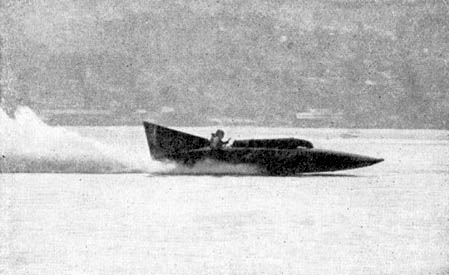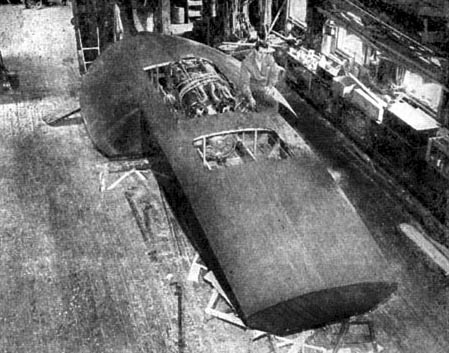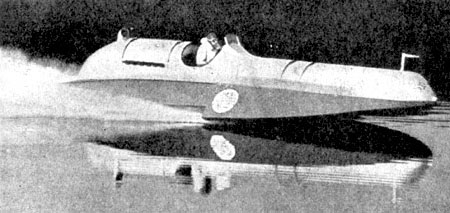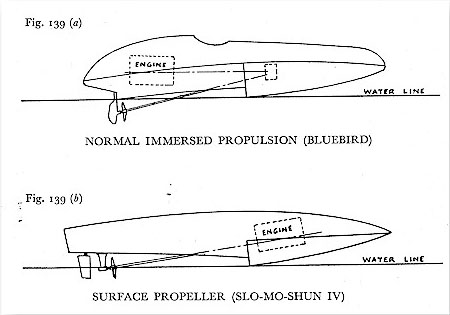Record-Breakers [1951]

The problem here is a specialised one. The first requirement to decide is the speed which has to be reached and under what conditions.
If we are considering an unlimited speed record it may be assumed that the craft has only to run over a measured mile. This presupposes that the qualities of turning and/or maneuverability and sea-worthiness are not a major consideration.
In fact the major consideration here is that the boat shall keep running as straight as possible, with the minimum effort or skill required on the part of the driver.
It is necessary to decide whether any known power unit seems likely to achieve this result if installed in a hull of reasonable proportions and of a form whose qualities can be expected to allow the necessary high-speed running to be carried out with safety without the exercise of undue skill.
For the most part and for some time to come the most likely propelling units will be those already developed for racing or attacking in the air.
The types of hull so far developed for racing purposes and high-speed running have in the main been built in fair numbers. At least sufficient examples are available elsewhere to study and form an opinion as to their qualities, limitations, etc.
In the case of the present world's record-holding Slo-Mo-Shun IV (26th June 1950), as well as the Bluebird, which held the record over more than ten years, the three-point form as originally developed by Arno Apel in the U.S.A. has seemed to offer the best all-round solution.

The problem is mainly one of producing a form which at speed will retain minimum contact with the water, sufficient to ensure stability both hydrodynamically and aerodynamically.
The reason, of course, why the area-reducing qualities are important is in order to reduce resistance to forward motion due to the friction set up by the water passing the surface of the boat in contact with the water. The remaining resistance will mostly be due to the passage of the hull through the air.
Both of the two above-mentioned boats have obviously had considerable thought expended upon them by those responsible for their design, especially in connection with the problem of avoiding dangerous qualities from an aerodynamic point of view. Put shortly, the danger here is that the forward end of the boat, which on the under side forms a sort of tunnel between the bottom of the boat and the water, will lift. Prevention of this lifting has to be undertaken by some form of spoiler or its equivalent, the function of which is to stop or break down the flow of air under the bottom of the boat, as well as over the top side or decking.
In arriving at a possible form a great many models will undoubtedly have to be tested in an experiment tank, as well as in a wind tunnel. Further models, which may possibly be the same as those used in the experiment tank, will quite likely have also to be tested for behaviour under realistic conditions on the water.
Unfortunately in order to obtain reliable results from a wind tunnel a large model is necessary of such dimensions that no "tank" could run it at anything approaching the equivalent "scale" speed. The above-mentioned factor causes one of the limitations to this type of investigation, as what might be called the "water" model will have to be of about 14 in. in length, while the model for the wind tunnel may well be g ft. This is the case at least where speeds in the neighbourhood of 200 m.p.h. are in contemplation. A more technical explanation of this will be found in the chapter on model testing and Reynolds number. The requirement here' is that Reynolds number for model in air and in water should both be such that turbulent flow conditions exist.
The results of the experiments carried out on the water and in the air have to be studied separately at first, then married up to enable a judgment to be formed as to the likely behaviour of the craft.
It is true to say that an experiment tank, if the carriage is fast enough to permit of a reasonable-sized model being used, can reproduce actual conditions as far as the combination of water and air effects are concerned. Owing, however, to the greatly differing Reynolds number between the model and full scale, the aerodynamic effects are not satisfactorily or reliably reproduced. At least absolute reliance cannot be placed upon these results, because of the necessity for ensuring turbulent flow in each case.
Having decided upon the correct shape of bottom or running surfaces, combined with an overall form possessing good aerodynamic qualities, we must scheme out a structure and machinery installation which will do the job. The structure alone involves problems calling for utmost judgment and ingenuity. If too heavy, the craft may not achieve the necessary speed; if too light, it may collapse.
In 1939 Bluebird was launched on a Monday, and by Friday Sir Malcolm Campbell had broken the world's record by a substantial margin, which was only exceeded more than ten years later on 26th June 1950 in the U.S.A. In this case success, beside brilliant handling by Sir Malcolm, was due in large measure to the fact that the engine installation, including steering gear and under-water fittings, had already been developed successfully in a previous boat. This applied also to the "vee" drive, which represents a mechanical problem of no mean order.
When success comes rapidly one is apt to think the problem has been easy, but unknown and unnoticed and almost forgotten by those involved in solving the many design problems have probably been many a trial model which failed, until finally one shows signs of behaving properly. This is eagerly concentrated upon, altered here and there, and tested again and again, until the prospects seem good enough to justify going ahead on the full-scale job.
Even then many very real problems still exist, because, though a model may have run satisfactorily, it still remains to produce a structure strong enough to take the stresses involved in traveling at high speed over the water while remaining light enough to achieve the necessary speed with the power available.
In the particular case of the "Apel" three-point type of hull, at high speed under optimum conditions the whole weight of the boat tends to be supported upon the aft inboard points on the under side of each sponson.
This feature, while reducing the friction drag to the minimum extent, does at the same time result in a high concentration of load which results in the necessity for very careful structural design in the matter of securing the sponsons to the main hull. In the case of the Bluebird a continuous cross-member in high-duty alloy was worded transversely from one side to the other, in such a manner that the loads on the sponsons could be transmitted directly to the longitudinal girders which ran the full length and depth of the boat.
All craft of this type are susceptible to "porpoising", which is really a longitudinal instability resulting from out-of-balance forces in the dynamic sense. This phenomenon is discussed in detail in Chapter XVIII [of High-Speed Small Craft] on Dynamic Stability so need not be enlarged upon here.
It is perhaps, however, of interest to say that in a large number of cases where models have been tested with a view to achieving really high speeds, this porpoising has shown itself in the model running stage so that it was possible to avoid it in the full-scale craft.
There are, however, cases where porpoising can intervene to mar performance in the full-scale craft despite the fact that the models have been quite unblemished in this respect.
In a case such as this very careful consideration will have to be given to any possible differences between the model and full scale.
When considering dynamic forces, for instance, the effect of the moment of inertia or radius of gyration of the model in relation to the full scale will have to be considered as it is not of necessity faithfully reproduced simply by having a model of the correct scale linear dimensions and displacement. To reproduce the radius of gyration will probably involve very exceptional model-making technique, as the tendency will be for the skin to be too heavy in the model. In other words, radius of gyration will be excessively large.
Another point of difference which can arise, especially in the case of jet- or rocket-propelled models, refers to thrust line. In the case of a towed model, it is not always quite straightforward to produce this, especially where a horizontal above-water thrust line may be envisaged.
In the case of the employment of jet engines there can also arise aerodynamic effects in the full scale which are not likely to be reproduced in the model. This is not difficult to understand when it is considered that the velocity of the jet in close proximity to the water surface at the stern of the boat will be of the order of 1,000 m.p.h., while very considerable acceleration of air over the forward surfaces will take place in the neighbourhood of the air intakes. Both of these effects are difficult, if not impossible to reproduce in a model, and both of them could have some effect in causing undesirable, pitching moments.
To refer back to Slo-Mo-Shun IV, whose performance in June 1950, in first taking the World's Unlimited Water Speed Record at 160.32 m.p.h., then winning the Gold Cup and Harmsworth races has undoubtedly made it the outstanding boat of many years, a few observations are offered with great diffidence. No more is known to the author than has been published, but careful study brings out the following rather interesting points
It would not appear to be an exaggeration to say that both boats are basically of the "three-point" type, although in fact Slo-Mo-Shun IV is claimed by the designer to be of a four-point type. Descriptions appearing in the technical press point to the fact that the fourth step or point of contact will only come into action in the event of some undesirable pitching or longitudinal change of trim taking place. This fourth step appears to fill up a considerable amount of the space normally available between the surface of the water and the bottom of the hull, so that it has the dual function of acting as a damper to longitudinal oscillations (porpoising) as well as a spoiler of aerodynamic lift by virtue of the fact that it produces the air gap above referred to.

Apart, however, from these differences it would appear that a very cleverly schemed construction has been employed, as a displacement of 4,300 lb. including pilot and mechanic has been achieved according to the reports, in comparison with 5,200 lb. in the case of the previous record-holding Bluebird with one pilot. This in itself represents a very considerable achievement; and having regard to the fact that the Allison engine installed is alleged to produce something like 1,800 b.h.p. at 3,200 r.p.m. as against about 1,940 b.h.p. in the case of the Bluebird as run in 1939 the difference in speeds achieved is understandable.
To be fair, however, the performance is all the more creditable when it is realised that this boat has been successful in races around a course requiring a considerable degree of maneuverability and "seaworthiness" as opposed to simply having to achieve a very high speed in a straight line.
It is worthy of note that the boat was first launched in August 1949 and was subject to something like nine months' trials on the water with no publicity whatever until the record had been achieved.
The structure is said to be mainly of plywood faced with aluminium on the running surfaces, in which respect it is very similar to the Bluebird, though exact details of the structure are not known.
In both cases the propeller design must be considered to be of extreme interest and of outstanding importance. In both cases two-bladed propellers were employed, reference to which will be found in Chapter XVI [of High-Speed Small Craft].
| Leading Particulars World's Record Breakers 1939-50 |
||
| Slo-Mo-Shun IV* | Bluebird† | |
| Date | 1950 | 1939 |
| Record Speed | 160.32 m.p.h. | 141.7 m.h.p. |
| Length (overall) | 28 ft. | 27 ft. |
| Beam (over sponsons) | 11 ft. 5 in. | 10 ft. 10 in. |
| Displacement (In record-breaking trim) | 4300 lb. | 5,065 lb. |
| B.H.P. | 1,600 ‡ | 1950 § |
| Revolutions | 3,300 | 3,150 |
| Propeller | Pitch 25 in. | Pitch 20.5 in. |
| Dia. 13? in. | Dia. 14 in. | |
| Two blades | Two blades | |
| Gear Ratio | 3:01 | 2.85 : 1 |
| Engine/Propeller | ||
| Fuel | 75 gallons ¶ | 25 gallons |
* Figures inserted here are obtained from various published sources and are believed to be reasonably correct.
† These figures relate to Bluebird as run at time of breaking World's Water Speed Record in 1939.
‡ This figure is based on the fact that the Allison gives 1,475 b.h.p. at 2,600 r.p.m. and that the engine revolutions recorded on the record-breaking runs are said to be 3,200. It should be stated that since preparing the table the designer (Ted Jones) has estimated the horse power as low as 1,200.
§ Based upon estimates made by Rolls Royce-the "ram effect" here is somewhat difficult to estimate.
¶ Probably not carried on record-breaking runs.
The cynical mind might be inclined to say of these water speed record breakers that they consist in the production of an aeroplane which will only just not fly, but while records are there for the taking man will undoubtedly continue to strive after them.
No outstanding difficulty would appear to be involved in producing a craft capable of speeds well beyond the 200 m.p.h. region in the reasonably near future. How far the normal system of propulsion by propeller would remain effective is difficult to conjecture, but some form of jet or reaction propulsion will presumably be used in this case.
The outstanding qualities of Slo-Mo-Shun IV are claimed by the designer to be due in large measure to the fact that she is what is termed in the U.S.A. a "proprider".
The boat is so designed and trimmed here that at high speed the propeller is only immersed up to approximately the centre of the boss.
In this way the "drag" or resistance caused by the necessity to pull the shafting and propeller strut through the water at high speed is eliminated.
In the case of high-speed craft in the record-breaking category this drag forms a high proportion of the water resistance. It will also be appreciated that at, say, 160 m.p.h. the resistance due to the passage of the above-water portion of hull through the air is a large proportion of the whole.
Even in the case where the shafting and propeller bracket are clear of the water there will, of course, still be a rudder immersed as well as such surfaces of the hull as are in contact with the water and which form the running surfaces.
The advantage offered here is substantial, though it must be anticipated that very careful control of the fore-and-aft trim will gave to be achieved in order to ensure a satisfactory degree of immersion of the lower half of the propeller under varying thrust conditions.

It can also be anticipated that a tendency to cavitate will arise due to the fact that the propeller blades actually break the surface.
Study of the special propellers designed for Slo-Mo-Shun IV will reveal a special technique here as the blades appear to widen progressively to the periphery where they reach a maximum. It is also said that the section is unusual in that the entry is a fine point while the thickness progressively increases to the trailing edge resulting in a wedge-shaped section.
It would be impertinence on the part of the author to attempt to criticise or explain these features in more detail or to attribute the success of this craft to any particular feature, but it must suffice to say that the results are highly instructive and should give food for much thought.
(Reprinted from High-Speed Small Craft by Peter Du Cane [1951], 1st ed., pp.259-267)
